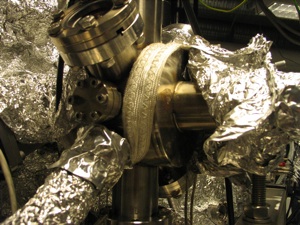bakeout of a UHV system

In order to obtain UHV, a system needs to be “baked”, i.e. heated to high temperatures (100 - 300 degrees C or so). The reason is that rest gas (mostly water) is adsorbed to the chamber walls and the vapour pressure from the water is so high that the system does not go into the UHV range. This also means that the water slowly desorbs and is thus pumped away but this takes a very, very long time at room temperature.
The bakeout is performed in order to accelerate this process. Baking the system can take a long time because everything inside has to reach the high temperature at which the water (or other contamination) is desorbed. Especially for complicated chambers with a many thermally well-insulated components inside, getting everything to high temperatures (and down again) is necessarily slow.
There are different possibilities for heating the chamber, some are shown below. Electrical heating tapes can be used which are wrapped around the different parts of the chamber (shown in the picture below). Then everything is covered with aluminium foil for insulation and heat distribution. An easier solution is to put the whole chamber in an insulated box with some heaters inside. The downside of this is the lack of flexibility. If you decide to attach something later to your chamber, the boxes might be too small. A good possibility are also heating tents around the chamber, again with a heater (and sometimes a fan) in the tent.

Even if you use boxes or a tent, it is necessary to cover viewports and electrical feedthroughs with aluminium foil before bakeout to avoid thermal stress across these.
